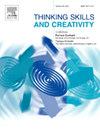The influence of social exclusion on bystanders’ retaliatory malevolent creativity
IF 4.5
2区 教育学
Q1 Social Sciences
引用次数: 0
Abstract
Research suggests that social exclusion enhances the retaliatory malevolent creativity of the excluded. However, its influence on the retaliatory malevolent creativity of bystanders, another key group in social exclusion, remains unknown. Two studies were conducted to investigate how social exclusion, particularly when coupled with attacks from excluders or the excluded, shapes bystanders’ retaliatory malevolent creativity. Study 1 and Study 2 recruited 69 and 74 participants, respectively. In both studies, participants were randomly assigned into the social exclusion group or control group. The social exclusion group underwent two blocks of social exclusion manipulation, while the control group experienced two blocks of sham exclusion manipulation. Following each manipulation, participants completed a retaliatory malevolent creative ideation task (MCT) targeting the excluded in Study 1 and excluder in Study 2. Study 1 showed that, only in the second block, the exclusion group exhibited higher MCT performance (fluency, originality, and malevolence) targeting the excluded than the control group. In study 2, the excluded group demonstrated significantly higher MCT performance targeting excluder exclusively in the first block than the control group. This exclusion effect on bystander’s retaliatory malevolent creativity was not mediated by the bystander’s sympathy or aggression. These findings indicate that simply witnessing social exclusion may increase bystanders’ retaliatory malevolent creativity toward both excluder and the excluded. Notably, the timing of this effect varies depending on the target of the MCT task, and its underlying mechanisms may involve factors other than aggression or empathy such as moral disengagement.
社会排斥对旁观者报复性恶意创造力的影响
研究表明,社会排斥增强了被排斥者的报复性恶意创造力。然而,它对旁观者(社会排斥的另一个关键群体)的报复性恶意创造力的影响尚不清楚。进行了两项研究,以调查社会排斥,特别是当与排斥者或被排斥者的攻击相结合时,如何塑造旁观者的报复性恶意创造力。研究1和研究2分别招募了69名和74名参与者。在这两项研究中,参与者被随机分配到社会排斥组或对照组。社会排斥组接受两组社会排斥操作,对照组接受两组假排斥操作。在每个操作之后,参与者完成了针对研究1中被排除者和研究2中被排除者的报复性恶意创意任务(MCT)。研究1显示,只有在第二个区域,被排除组针对被排除者的MCT表现(流畅性、独创性和恶意)高于对照组。在研究2中,被排除组在第一区块的MCT表现明显高于对照组。这种对旁观者报复性恶意创造力的排斥效应不受旁观者的同情或攻击的调节。这些发现表明,仅仅目睹社会排斥可能会增加旁观者对排斥者和被排斥者的报复性恶意创造力。值得注意的是,这种效应的时间取决于MCT任务的目标,其潜在机制可能涉及攻击或共情以外的因素,如道德脱离。
本文章由计算机程序翻译,如有差异,请以英文原文为准。
求助全文
约1分钟内获得全文
求助全文
来源期刊

Thinking Skills and Creativity
EDUCATION & EDUCATIONAL RESEARCH-
CiteScore
6.40
自引率
16.20%
发文量
172
审稿时长
76 days
期刊介绍:
Thinking Skills and Creativity is a new journal providing a peer-reviewed forum for communication and debate for the community of researchers interested in teaching for thinking and creativity. Papers may represent a variety of theoretical perspectives and methodological approaches and may relate to any age level in a diversity of settings: formal and informal, education and work-based.
 求助内容:
求助内容: 应助结果提醒方式:
应助结果提醒方式:


